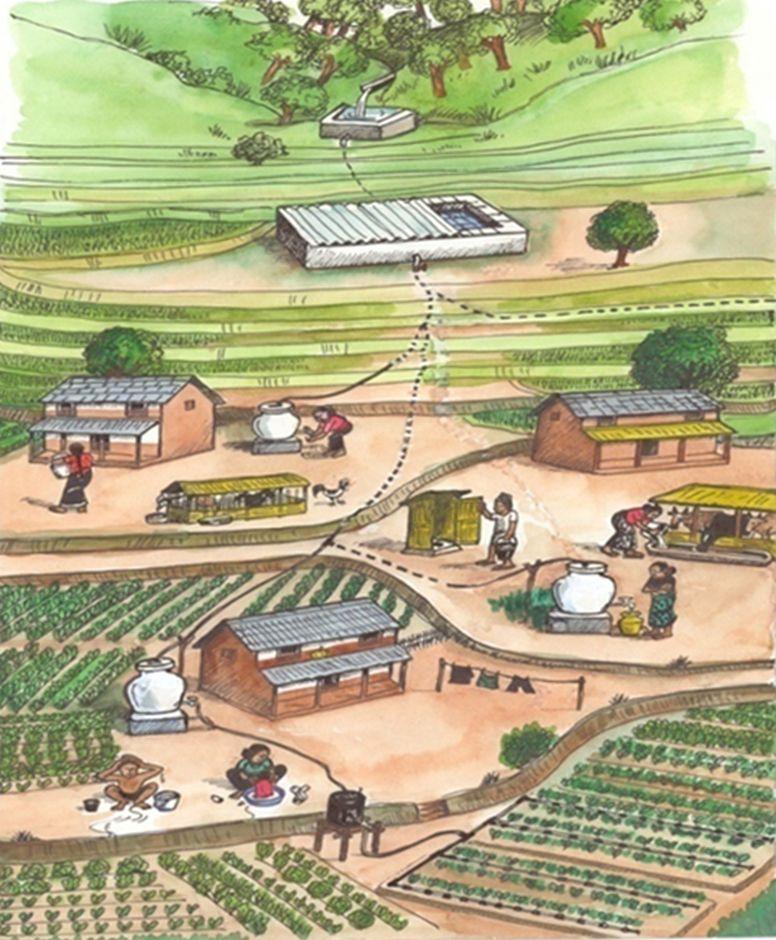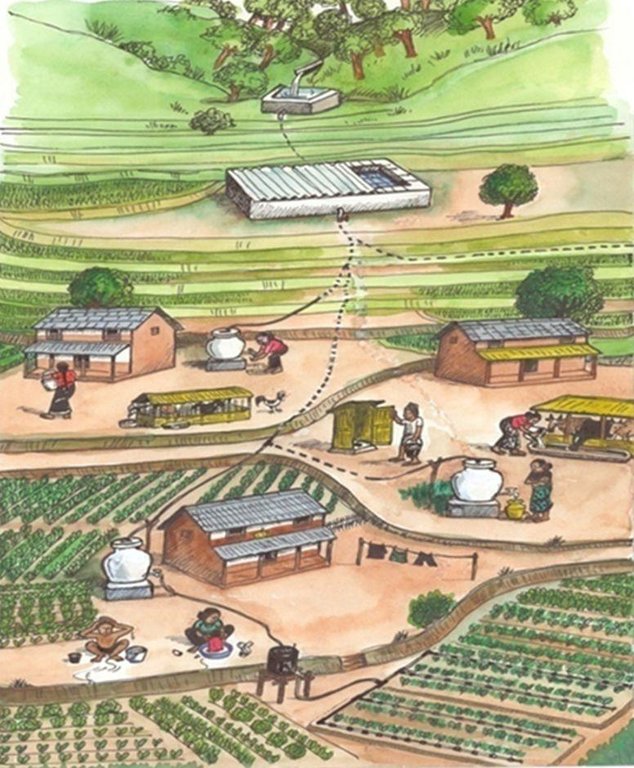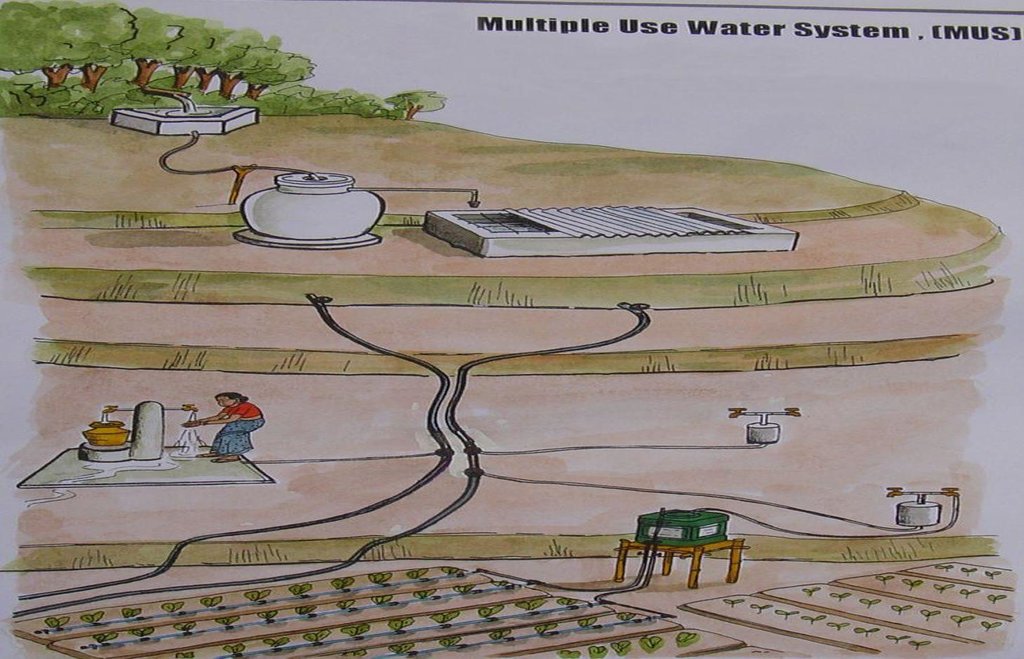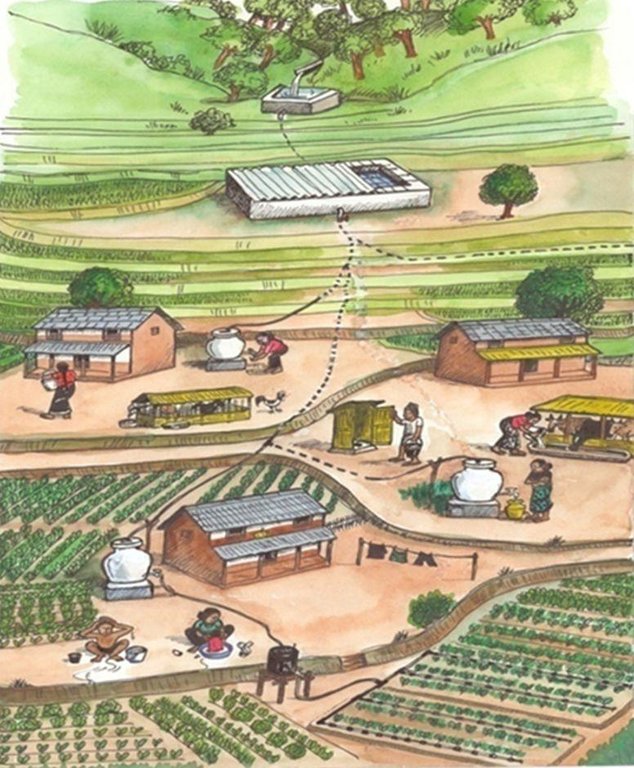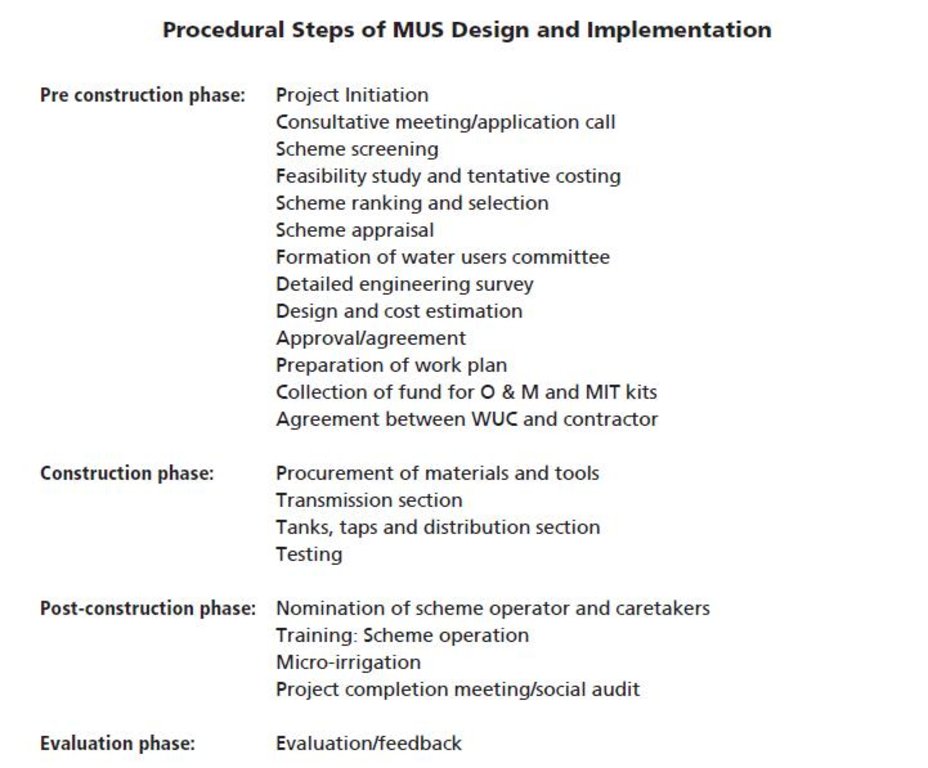A multiple-use water system [Nepal]
- Creación:
- Actualización:
- Compilador: Shreedip Sigdel
- Editor: –
- Revisor: Fabian Ottiger
Bahu uddhasaya Pani prayog pranali (Main contributor: Parmananda Jha, IDE/Nepal)
approaches_2532 - Nepal
Visualizar secciones
Expandir todo Colapsar todos1. Información general
1.2 Detalles de contacto de las personas de referencia e instituciones involucradas en la evaluación y la documentación del Enfoque
Especialista MST:
Jha Parmananda
98487 28274 / 97495 12791 (M)
pjha@idenepal@org / jhap-2003@yahoo.com
Food Security Project, Regional Office, Banke Bagiya, Shantinagar,Nepalgunj
Nepal
Nombre de la(s) institución(es) que facilitaron la documentación/ evaluación del Enfoque si fuera relevante)
iDE Nepal (iDE Nepal) - NepalNombre de la(s) institución(es) que facilitaron la documentación/ evaluación del Enfoque si fuera relevante)
ICIMOD International Centre for Integrated Mountain Development (ICIMOD) - Nepal1.3 Condiciones referidas al uso de datos documentados mediante WOCAT
¿Cuándo se compilaron los datos (en el campo)?
01/03/2013
El compilador y la/s persona(s) de referencia claves aceptan las condiciones acerca del uso de los datos documentados mediante WOCAT :
Sí
2. Descripción del Enfoque MST
2.1 Breve descripción del Enfoque
A multiple-use water system gives a community access to water for domestic use and water for crop irrigation.
2.2 Descripción detallada del Enfoque MST
Descripción detallada del Enfoque MST:
Aims / objectives: A multiple-use water system (MUS) is a combined water facility that has proven useful as a means of providing drinking water and water for irrigation for smallholder farmers in the hilly areas of Nepal. Water is collected by gravity from a highland source into a holding tank and is shared by means of distribution lines, domestic tap stands, and irrigation off-take lines. It can also support application of micro-irrigation technologies (MIT) such as drip and micro sprinkler irrigation systems.
Methods: MUS is a community-managed system that caters mainly to smallholder landowners and marginal households in rural hilly areas. When properly implemented, it can help to alleviate poverty and increase food security for poor and marginalized groups. The first priority is to provide drinking water and water for domestic use to the community; any excess water is used for agriculture and irrigation.
Stages of implementation: The following points should be taken into consideration before a community establishes a MUS:
• The source of water should be clear of water-rights issues
• The water should be plentiful and of good quality
• There needs to be a sufficient drop in gradient between the source and the tank if the water is to be collected by gravity. If the drop is not sufficient, users should be prepared to consider lifting the water.
• The distance between the source and the village should be less than 3 km.
• The community should be ready to contribute unskilled labour as part of their contribution to the project.
• The community should be ready to put aside some funds for operational and maintenance costs; these funds can, in part, also be collected in the form of monthly users' fees.
• At least 70% of the water users should be ready to adopt micro-irrigation technologies (MIT) such as drip and sprinkler irrigation.
2.3 Fotos del Enfoque
2.5 País/ región/ lugares donde el Enfoque fue aplicado
País:
Nepal
Especifique más el lugar :
Kaski, Lamjunj, Tanahun, Dhading, Sangjya, Gulmi, Arghakhanchi, Palpa, Udayapur, Pyuthan, Rolpa, Ruk
2.7 Tipo de Enfoque
- proyecto/ basado en un programa
2.8 Propósitos/ objetivos principales del Enfoque
The Approach focused mainly on other activities than SLM (Collect water from a small-scale source and distribute it both for domestic use and for the production of vegetables and high value crops)
• To provide a regular supply of water for domestic and agricultural use
• To supply water for micro-irrigation technologies such as drip and sprinkler irrigation systems
• To improve health and sanitation
• To help smallholder landowners improve their incomes and livelihoods as well as to adapt to climate change by having access to a regular supply of water so that they can grow crops regardless of changes
• To conserve water by using it more wisely
The SLM Approach addressed the following problems: The community needs to prioritize how it will partition the water for domestic use and for irrigation.
2.9 Condiciones que facilitan o impiden la implementación de la/s Tecnología/s aplicadas bajo el Enfoque
normas y valores sociales/ culturales/ religiosos
- impiden
Management and operation of system
Treatment through the SLM Approach: Strong social mobilization is needed
marco de trabajo legal (tenencia de tierra, derechos de uso de tierra y agua)
- facilitan
The existing land ownership, land use rights / water rights helped a little the approach implementation: Since this approach uses small spring sources of water, there is usually only a minimum risk of conflict for water use. When the water source is registered with the local authorities, it helps to reduce potential conflicts over water rights between communities.
conocimiento de MST, acceso a apoyo técnico
- impiden
Water supply insufficient to meet the demand
Treatment through the SLM Approach: Increase the capacity of the storage tank
otros
- impiden
The community often cannot agree whether to scale up the domestic or the irrigation water supply.
Treatment through the SLM Approach: Concerned stakeholders need to confer and agree
3. Participación y roles de las partes interesadas involucradas
3.1 Partes interesadas involucradas en el Enfoque y sus roles
- usuarios locales de tierras/ comunidades locales
This included women, men, dalits, janjati, brahmin, chhetri
- especialistas MST/consejeros agrícolas
- profesores/ niños en edad escolar/ estudiantes
- ONG
IDE Nepal
- gobierno nacional (planificadores, autoridades)
3.2 Involucramiento de los usuarios locales de tierras/ comunidades locales en las distintas fases del Enfoque
| Involucramiento de los usuarios locales de tierras/ comunidades locales | Especifique quién se involucró y describa las actividades | |
|---|---|---|
| iniciación/ motivación | interactivo | The community comes to a consensus on their water needs. They identify a source that it is within the 3 km limit and investigate the water use rights. |
| planificación | auto-movilización | Technical aspects are dealt with; these include assessing the source to verify whether it has an adequate supply of water, assessing different schemes (for intake, take off, tap stands, and the like), preparing a design and estimating the cost, and discussing funding. |
| implementación | auto-movilización | A users' committee is formed and the community provides unskilled labour. Technical assistance is provided by INGOs/NGOs. |
| monitoreo y evaluación | auto-movilización | The work is monitored by the users' committee but monitoring and evaluation of technical aspects are provided by INGOs/NGOs at different times during the project. |
| Research | ninguno |
3.3 Flujograma (si estuviera disponible)
3.4 La toma de decisiones en la selección de Tecnología(s) MST
Especifique quién decidió la selección de las Tecnología/ Tecnologías a implementarse:
- solamente usuarios de tierras (autoiniciativa)
Explique:
The community discusses and makes a decision on the type of water supply system they would like and specifies how they would like to apportion water for domestic and agricultural use. They submit a proposal to the concerned authorities.
Decisions on the method of implementing the SLM Technology were made by mainly by land users supported by SLM specialists. Technical support is provided by IDE Nepal in collaboration with different national and international non-governmental organizations, government organizations, and local bodies.
4. Apoyo técnico, fortalecimiento institucional y gestión del conocimiento
4.1 Construcción de capacidades / capacitación
¿Se proporcionó la capacitación a usuarios de tierras/ otras partes interesadas?
Sí
Especifique quién fue capacitado:
- personal de campo/ consejeros
- Community
Forma de capacitación:
- de agricultor a agricultor
Temas avanzados:
The approach provided training to the community through the users' committee, field staff, and an agricultural advisor. The local skilled body is trained during site visits. For the most part, information is transferred from farmer to farmer. Much of the training is hands-on.
4.2 Servicio de asesoría
¿Los usuarios de tierras tienen acceso a un servicio de asesoría?
Sí
Especifique si servicio proporcionado se realizó:
- en centros permanentes
Describa/ comentarios:
An advisory service is provided for the land/water users, but what is given is usually insufficient to help farmers learn new techniques such as micro-irrigation.
4.3 Fortalecimiento institucional (desarrollo institucional)
¿Se establecieron o fortalecieron instituciones mediante el Enfoque?
- sí, moderadamente
Especifique el nivel o los niveles en los que se fortalecieron o establecieron las instituciones:
- local
Especifique el tipo de apoyo:
- construcción de capacidades/ entrenamiento
Proporcione detalles adicionales:
village development committees, local governance and community development programmes (LCGDP), community forest user groups, youth clubs, and women's groups. Village development committees can invest in MUS and micro-irrigation technologies as specified in their guidelines.
4.4 Monitoreo y evaluación
¿El monitoreo y la evaluación forman parte del Enfoque?
Sí
Comentarios:
bio-physical aspects were regular monitored by project staff, land users through measurements; indicators: Project staff and land users routinely monitor the water source and other biophysical aspects to ensure that the approach remains sustainable.
technical aspects were regular monitored by land users through observations; indicators: Commercial vegetable or high value crop production, micro irrigation, drinking water and sanitation
socio-cultural aspects were ad hoc monitored through observations; indicators: MUS schemes help to improve sanitation and thereby reduce the incidence of waterborne diseases. They also help to improve livelihoods by making more fresh vegetables available both for immediate consumption and for sale.
economic / production aspects were monitored through observations; indicators: MUS schemes help to reduce drudgery; the labour saved can be used in the production of vegetables and other high value crops.
no. of land users involved aspects were monitored through measurements; indicators: From 10 to 80; on average 28 land users are involved in one MUS scheme
management of Approach aspects were monitored through observations; indicators: Participatory approach with collaboration by government organizations, INGOs/NGOs and others to provide routine inspections and technical support
There were no changes in the Approach as a result of monitoring and evaluation: The approach, as it is now put into practice, is a result of incorporating technological improvements that were originally identified through years of monitoring and evaluation.
There were no changes in the Technology as a result of monitoring and evaluation
4.5 Investigación
¿La investigación formó parte del Enfoque?
Sí
Especifique los temas:
- tecnología
Proporcione detalles adicionales e indique quién hizo la investigación:
IDE has researched and implemented this type of MUS concept, system design, and methodology in Nepal since 2003; now other agencies also provide similar systems.
Research was carried out both on station and on-farm
5. Financiamiento y apoyo material externo
5.1 Presupuesto anual para el componente MST del Enfoque
Si no se conoce el presupuesto anual preciso, indique el rango:
- 10,000-100,000
Comentarios (ej. fuentes principales de financiamiento/ donantes principales):
Approach costs were met by the following donors: international non-government: 30.0%; local government (district, county, municipality, village etc): 26.0%; local community / land user(s): 44.0%
5.2 Apoyo financiero/material proporcionado a los usuarios de tierras
¿Los usuarios de tierras recibieron financiamiento/ apoyo material para implementar la Tecnología/ Tecnologías? :
Sí
Si respondió sí, especifique el tipo o los tipos de apoyo, condiciones y proveedor(es) :
All MUS systems in Nepal are built by communities or community groups in collaboration with the government and NGOs. The fact that MUS systems provide multiple benefits is seen as a plus point for institutions looking to invest in community projects.
5.3 Subsidios para insumos específicos (incluyendo mano de obra)
Si la mano de obra de usuarios de tierras fue un insumo sustancial, ¿fue:
- pagado en efectivo?
Comentarios:
Unskilled labour is provided by the community; skilled labour is provided by the implementing organization. The implementing organization pays for both the skilled and unskilled labour.
Materials that are available locally are contributed by the community. Materials that are not available locally are paid for out of project funds. Equipment, tools, and specialist materials are purchased through collaborative partners. Training programmes aimed at capacity building and upgrading skills are subsidized.
5.4 Crédito
¿Se proporcionó crédito bajo el Enfoque para actividades MST?
No
6. Análisis de impacto y comentarios de conclusión
6.1 Impactos del Enfoque
¿El Enfoque ayudó a los usuarios de tierras a implementar y mantener Tecnologías MST?
- No
- Sí, un poco
- Sí, moderadamente
- Sí, mucho
The approach supports sustainable land management because micro- irrigation technologies promote optimal use of water and help to retain nutrients in the soil. Similarly, the production of high value crops and vegetables further increases the fertility of the soil.
¿El Enfoque empoderó a grupos en desventaja social y económica?
- No
- Sí, un poco
- Sí, moderadamente
- Sí, mucho
The wellbeing of marginalized and socio-economically disadvantaged groups improves significantly.
Did other land users / projects adopt the Approach?
- No
- Sí, un poco
- Sí, moderadamente
- Sí, mucho
Since the reduction in drudgery and the improvements in livelihoods are so great, many communities would like to implement this approach. INGOs/NGOs can help with the financial and technical aspects of implementation.
Did the Approach lead to improved livelihoods / human well-being?
- No
- Sí, un poco
- Sí, moderadamente
- Sí, mucho
This approach helps to reduce drudgery and to improve sanitation; overall, it improves livelihoods and contributes to human wellbeing. It also increases the production of crops, and helps to conserve the soil and improve its fertility.
Did the Approach help to alleviate poverty?
- No
- Sí, un poco
- Sí, moderadamente
- Sí, mucho
Through increased income from the production of vegetables and high value crops
6.2 Motivación principal del usuario de la tierra para implementar MST
- producción incrementada
- incremento de la renta(bilidad), proporción mejorada de costo-beneficio
- well-being and livelihoods improvement
6.3 Sostenibilidad de las actividades del Enfoque
¿Pueden los usuarios de tierras sostener lo que se implementó mediante el Enfoque (sin apoyo externo)?
- sí
Si respondió que sí, describa cómo:
Since the approach was requested by the community as a whole, they all have a vested interest in seeing that it remains sustainable. When technical support is needed, it can be obtained from the concerned agencies.
6.4 Fortalezas/ ventajas del Enfoque
| Fuerzas/ ventajas/ oportunidades desde la perspectiva del compilador o de otra persona de referencia clave |
|---|
| A reliable water supply for both the domestic and irrigation needs of hill farmers (How to sustain/ enhance this strength: The continued involvement of the community, the government, and assisting INGOs/NGOs.) |
| The MUS is a simple gravity system that does not require either sophisticated equipment or training. (How to sustain/ enhance this strength: Continue to investigate how it can be simplified even further) |
| A MUS system has a minimum lifespan of ten years and is easy to install even in remote areas. (How to sustain/ enhance this strength: Continue to investigate how it can be improved even further) |
| MUS is well suited to the dual purpose use of water for both domestic and agricultural use. (How to sustain/ enhance this strength: Continue research and development to see how it can be improved even further.) |
6.5 Debilidades/ desventajas del Enfoque y formas de sobreponerse a ellos
| Debilidades/ desventajas/ riesgos desde la perspectiva del compilador o de otra persona de referencia clave | ¿Cómo sobreponerse a ellas? |
|---|---|
| Installation costs can be a challenge for very poor communities. It can only irrigate small areas (0.1-0.15ha). | Installation costs can usually be recovered within 1 year when the irrigation water is used to produce high value crops. |
| The intake and reservoirs need to be inspected regularly. | Either devise a means to ensure that inspections are conducted regularly or find a system that requires fewer inspections |
| Reservoir tanks and intake pipes can deteriorate over time and pipes and joints can start to leak. | Local skilled labour can be employed to carry out needed repairs. Pipes and fittings should be checked regularly. Routine inspection and maintenance are essential. |
| Costs can be high when imported materials are needed for repair and maintenance. | At the outset, some money needs to be set aside for operation and maintenance costs; additional funds should be collected by charging monthly users' fees. |
7. Referencias y vínculos
7.1 Métodos/ fuentes de información
- visitas de campo, encuestas de campo
- entrevistas con usuarios de tierras
7.2 Referencias a publicaciones disponibles
Título, autor, año, ISBN:
Multiple use water service implementation in Nepal and India: Experience and lessons for scale-up, Mikhail, M; Yoder, R (2008)
¿Dónde se halla disponible? ¿Costo?
http://www.ideorg.org/OurStory/IDE_multi_use_water_svcs_in_nepal_india_8mb.pdf
Vínculos y módulos
Expandir todo Colapsar todosVínculos
No hay vínculos
Módulos
No se hallaron módulos


